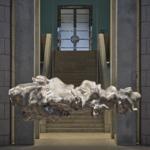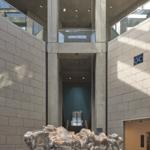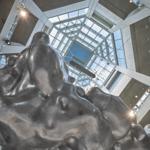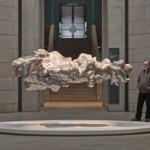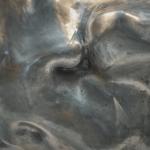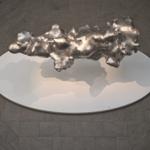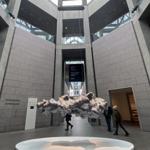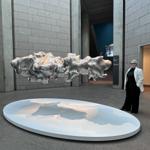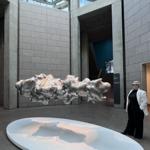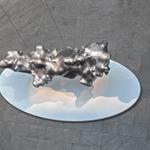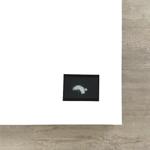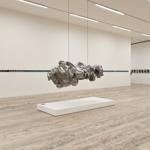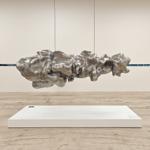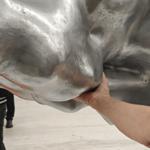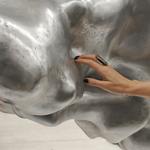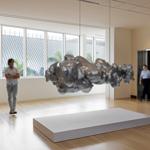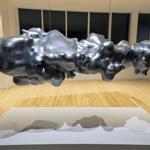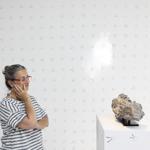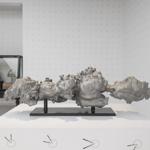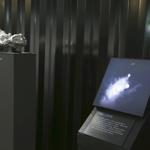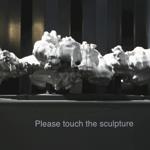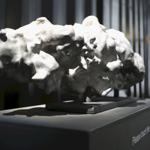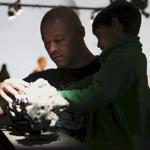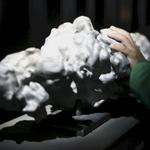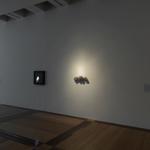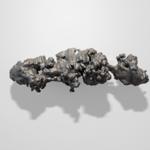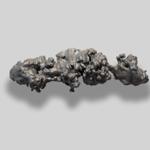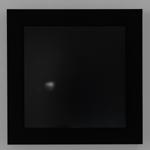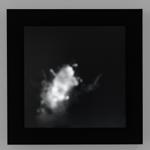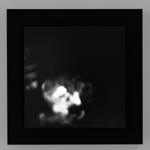Volute
In the "Volute" series —words, phrases, and songs—are rendered into turbulent clouds containing layers of complex folds and vortices, with a method developed by Lozano-Hemmer's studio in conjunction with fluid dynamic scientists from Georgia Institute of Technology, Auburn University, and NYU. A custom-made laser tomograph scans the breath exhaled while spoken, then converts it into a 3D shape using photogrammetry. This shape gets printed in high-definition stainless steel. Charles Babbage's 1837 statement: "The atmosphere is a vast library that contains all the words that have been spoken in the past," inspired the series.
At the same time, the series intones a vastly different tradition, that of the "speech-scroll" (also called a speech-bubble, banderole, phylactery or volute), an illustrative device similar to those used by Olmec, Mayan, Mixtec and other Pre-Columbian cultures to represent spoken words or song.
In 1860, Édouard-Léon Scott de Martinville recorded the phrase "Au clair de la lune" on his phonautograph, making the first known recording of human speech. In "Au Clair de la Lune, Volute 1," the exact phrase was materialized. In "Au, Volute 0," just the word "Au," was made from the previous phrase.
"Listen to the World, Volute 2," (2023) was made with a laser-tomography scan of the turbulent air ejected by a single human voice as it uttered the sentence: "Listen to the World." An homage to the influential composer R. Murray Schafer, who revolutionized the arts with his practice of acoustic ecology and his concept of the "soundscape," the sculpture renders the spoken word tangible. This piece is part of two permanent collections, National Gallery of Art in Ottawa and Jumex Collection in Mexico City.
At the same time, the series intones a vastly different tradition, that of the "speech-scroll" (also called a speech-bubble, banderole, phylactery or volute), an illustrative device similar to those used by Olmec, Mayan, Mixtec and other Pre-Columbian cultures to represent spoken words or song.
In 1860, Édouard-Léon Scott de Martinville recorded the phrase "Au clair de la lune" on his phonautograph, making the first known recording of human speech. In "Au Clair de la Lune, Volute 1," the exact phrase was materialized. In "Au, Volute 0," just the word "Au," was made from the previous phrase.
"Listen to the World, Volute 2," (2023) was made with a laser-tomography scan of the turbulent air ejected by a single human voice as it uttered the sentence: "Listen to the World." An homage to the influential composer R. Murray Schafer, who revolutionized the arts with his practice of acoustic ecology and his concept of the "soundscape," the sculpture renders the spoken word tangible. This piece is part of two permanent collections, National Gallery of Art in Ottawa and Jumex Collection in Mexico City.
General info
Spanish name:
Voluta
Year of creation:
2016
Volute 1: Au Clair de la Lune
Technique:
3D-printed polished aluminum, tomography video
Room conditions:
Natural or artificial light. The piece is silent and is not affected by other sounds.
Dimensions:
Sculpture: 65 x 19 x 21 cm Video: Variable dimensions
Additional info:
A laser-tomography scan of the turbulent air ejected by a single human voice as it uttered the sentence: “Au Clair de la Lune”
Edition:
6 Editions, 2 AP
Collectors:
Fondation Giverny pour l’art contemporain
Volute 0: Au
Technique:
3D-printed polished steel, tomography video
Room conditions:
Natural or artificial light, the piece is silent and is not affected by other sounds
Dimensions:
Sculpture: 7 x 7 x 6 cm
video: variable dimensions
video: variable dimensions
Weight:
0.5 kg
Additional info:
The word “Au” from the sentence of Volute 1
Edition:
35 Editions, 3 AP
Collectors:
private collectors
Volute 2: Listen to the World
Technique:
cast polished aluminum, steel cables
Room conditions:
Natural or artificial light, the piece is silent and is not affected by other sounds
Dimensions:
300 x 120 x 100 cm
Additional info:
A laser-tomography scan of the turbulent air ejected by a single human voice as it uttered the sentence: “Listen to the World.”
Edition:
3 Editions, 1 AP
Collectors:
Fundación Jumex Arte Contemporáneo, National Gallery of Canada
Exhibitions
- Obras de la Colección Jumex, Fundación Jumex Arte Contemporáneo, Mexico City, México, 2025 - 2026.
- Volute 2: Listen to the World, Museo Jumex, Mexico City, México, 2025.
- Listen to the World, Volute 2, National Gallery of Canada, Ottawa, Ontario, Canada, 2025.
- Rafael Lozano-Hemmer: Listen to the World, National Gallery of Canada, Ottawa, Ontario, Canada, 2025.
- Rafael Lozano-Hemmer: Obra Sonora, Artis - Naples, The Baker Museum, Naples, Florida, United States, 2024 - 2025.
- Virada Sônica - The Ascent of Sound in Contemporary Art, Farol Santander, São Paulo, Brazil, 2024.
- Travelling Gallery of Fluid Motion, Cultural Programs of the National Academy of Sciences, Washington, D.C., United States, 2023 - 2024.
- Atmospheric Memory, Manchester International Festival, Powerhouse Ultimo - Museum of Applied Arts and Science, Sydney, Australia, 2023.
- TECHS-MECHS: A Survey of Mexican Technological Culture, Gray Area Foundation for the Arts, Grand Theatre, San Francisco, California, United States, 2023.
- Rafael Lozano-Hemmer: Atmospheric Memory, Manchester International Festival, University of North Carolina, Chapel Hill, North Carolina, United States, 2021.
- Rafael Lozano-Hemmer: Unstable Presence, San Francisco Museum of Modern Art, San Francisco, California, United States, 2021 - 2022.
- Rafael Lozano-Hemmer: Presencia Inestable, Museo de Arte Contemporáneo de Monterrey, Monterrey, México, 2019 - 2020.
- Rafael Lozano-Hemmer: Atmospheric Memory, Manchester International Festival, Manchester, United Kingdom, 2019.
- Rafael Lozano-Hemmer: Confirmation Bias, bitforms gallery, New York City, New York, United States, 2018.
- Rafael Lozano-Hemmer: Présence instable, Musée d'art contemporain de Montréal, Montréal, Québec, Canada, 2018.
- Rafael Lozano-Hemmer: Decision Forest, Amorepacific Museum of Art, Seoul, South Korea, 2018.
- Collective V, Art Bärtschi & Cie, Genève, Switzerland, 2017.
- Untitled Art Fair, bitforms gallery, Miami, Florida, United States, 2016.
Credits
- Production: Stephan Schulz, Kitae Kim, Miguel Legaul, Sergio Clavijo
- Georgia Institute of Technology: S. Johnston, J. Imgrund, D. Fries and Devesh Ranjan
- Auburn University: K. Johnson, J. Bolton, C. Clifford and B. Thurow
- New York University: E. Fonda and K. Sreenivasan
- Production for Volute 2: Karine Charbonneau, Tim Belliveau, William Sutton, Rebecca Murdock, Kitae Kim
- Fonderie D’Art Inverness, USIM, Pierre Fournier, Julia Arvelo, Sophia Write
- Video: Matthieu Vanier
Links
Bibliography
- Baldi, Lisa. "Penn State Berks professor coordinates national art, science exhibition." Penn State University, 18 Oct. 2023. 2023. (english) (Websites)
- Bayley, Cameron. "New show may make you feel like you’re being watched. That’s because you are." The Sydney Morning Herald , 8 Aug. 2023. Sydney, Australia, 2023. (english) (Newspapers)
 Bulut, Zeynep. "Building a Voice: Sound, Surface, Skin." Goldsmiths Press, 12 Dec. 2024, 212-233. London, United Kingdom. (english) (Books)
Bulut, Zeynep. "Building a Voice: Sound, Surface, Skin." Goldsmiths Press, 12 Dec. 2024, 212-233. London, United Kingdom. (english) (Books) Canadian Media. "‘My work strives to make tangible the invisible’: Rafael Lozano-Hemmer." The Canadian Media , 5 May 2025. Canada. (english) (Websites)
Canadian Media. "‘My work strives to make tangible the invisible’: Rafael Lozano-Hemmer." The Canadian Media , 5 May 2025. Canada. (english) (Websites)- Diario de Noticias de São Paulo. "Virada Sônica: a escalada do som na arte contemporânea." Diario de Noticias de São Paulo, 5 July 2024. São Paulo, Brazil, 2024. (português) (Newspapers)
- El Universal. "Pintar con voz y cabello: el Jumex propone otras formas de ver." El Universal, 23 Sep. 2025. Mexico City, México. (español) (Newspapers)
 Tenorio Pearl, Gracia. "Rafael Lozano-Hemmer: The art of making the ephemeral tangible." National Gallery of Art Magazine, 17 Mar. 2025. Ottawa, Ontario, Canada. (english) (Magazines)
Tenorio Pearl, Gracia. "Rafael Lozano-Hemmer: The art of making the ephemeral tangible." National Gallery of Art Magazine, 17 Mar. 2025. Ottawa, Ontario, Canada. (english) (Magazines)
Photo Library (click to expand)

